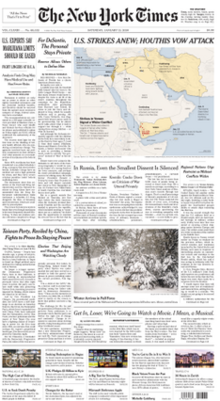Some Known Incorrect Statements About News Articles
Get This Report about News Articles
Table of ContentsThe Best Guide To News ArticlesThe Single Strategy To Use For News ArticlesThe smart Trick of News Articles That Nobody is DiscussingUnknown Facts About News ArticlesGetting My News Articles To Work
Excellent understanding of various subjects offers students an affordable edge over their peers. Despite the fact that electronic and social networks are readily obtainable, we ought to not neglect how crucial it is to read the papers. Moms and dads need to attempt and inculcate the routine of reviewing a newspaper as an everyday regimen to continue the heritage of the adored print medium.News stories also include at least one of the adhering to important qualities family member to the designated target market: distance, prestige, timeliness, human passion, oddity, or consequence.
Within these limitations, information stories also intend to be thorough. Amongst the larger and much more reputable newspapers, fairness and balance is a significant variable in providing info.
Newspapers with a global audience, for instance, tend to make use of a much more official style of creating. News Articles.; common design guides consist of the and the US Information Style Book.
News Articles Fundamentals Explained
Generally, journalists will not utilize a lengthy word when a brief one will certainly do. They make use of subject-verb-object construction and vibrant, active prose (see Grammar). They provide narratives, instances and allegories, and they seldom rely on generalizations or abstract concepts. Information authors attempt to prevent utilizing the exact same word greater than as soon as in a paragraph (occasionally called an "resemble" or "word mirror").
Headlines sometimes omit the topic (e.g., "Leaps From Boat, Catches in Wheel") or verb (e.g., "Cat female fortunate"). A subhead (likewise subhed, sub-headline, subheading, subtitle, deck or dek) can be either a subordinate title under the major heading, or the heading of a subsection of the post. It is a heading that precedes the main message, or a group of paragraphs of the primary text.

Added billboards of any of these kinds may appear later on in the short article (specifically on succeeding pages) to tempt additional reading. Such signboards are also made use of as tips to the article in various other sections of the publication or website, or as ads for the item in other magazine or sites. Normal framework with title, lead paragraph (summary in vibrant), other paragraphs (information) and contact info.

Example of a hard-lead paragraph NASA is suggesting another space project. The firm's spending plan demand, revealed today, included a plan to send an additional goal to the Moon. This moment the company wishes to establish a long-term facility as a jumping-off place for various other area experiences. The budget requests about $10 billion for the task.
The NASA announcement came as the firm asked for $10 billion of appropriations for the project. An "off-lead" is the 2nd crucial front page information of the day. The off-lead appears either in the leading left corner, or straight listed below the lead on the. To "bury the lead" is to start the short article with history info or details of second value to the readers, compeling them to check out even more deeply into an article than they need to have to in order to uncover the necessary points.
All about News Articles
Typical use is that or more sentences each form their own paragraph. Journalists normally define the organization or structure of a news story as an upside down pyramid. The crucial and most interesting elements of a story are put at the beginning, with supporting info complying with in order of lessening importance.
It allows people look at these guys to explore a topic to only the depth that their curiosity takes them, and without the imposition of information or nuances that they could consider irrelevant, but still making that information available to more interested readers. The inverted pyramid framework additionally makes it possible for write-ups to be cut to any kind of approximate length during layout, to fit in the room readily available.
Some authors begin their stories with the "1-2-3 lead", yet there are numerous kinds of lead readily available. This layout usually starts with a "Five Ws" opening up paragraph (as defined over), complied with by an indirect quote that serves right here to sustain a major element of the very first paragraph, and after that a direct quote to support the indirect quote. [] A twist can refer to multiple points: The last tale in the news broadcast; a "satisfied" tale to end the show.
Longer articles, such as publication cover posts and the pieces that lead the within sections of a paper, are called. Feature tales differ from straight information in a number of ways. Foremost is the lack of a straight-news lead, the majority of the moment. Instead of offering the significance of a story in advance, feature authors may try to lure viewers in.
7 Easy Facts About News Articles Explained
An attribute's initial paragraphs frequently relate an appealing minute or occasion, as in an "unscientific lead". From the details of an individual or episode, its view swiftly expands to generalizations concerning the tale's topic.

The Editor's Tool kit: A Recommendation Overview for Beginners and Professionals (2001) Allan M. Siegal and William G. Connolly. The New York Times Guidebook of Style and Use: The Official Design Guide Made Use Of by the Writers and go to website Editors of the World's The majority of Authoritative Paper (2002) M. L. Stein, Susan Paterno, and R.